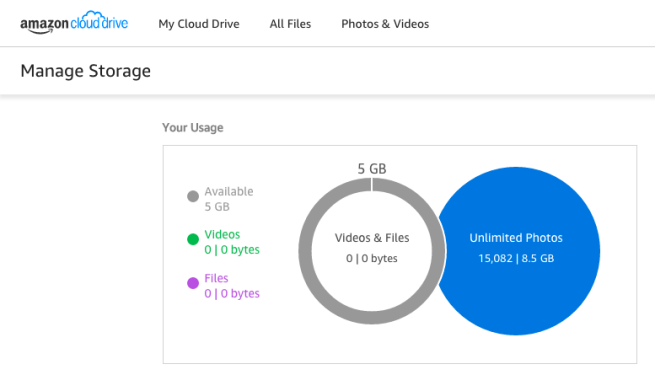I’ve been spending the past several days trying out different ways of getting my photos into the cloud.
First, I tried iCloud. Candidly, that was a terrible experience. As I was uploading my 180GB of photo and video files, iCloud rendered my Internet connection useless because it saturated the upstream connection; that caused me to write this post. But after I had gotten all of my data into iCloud, it became clear that iCloud wasn’t designed as a cloud-based photo backup service– instead, iCloud was designed to be your canonical photo store. This means that all your photos– on your iPhone, on your desktop, etc.– are simply mirrored, locally cached copies. If you don’t understand this, you’re not alone– neither do dozens of other people. I appreciate Apple’s attempts to make this work seamlessly, but personally, I want more control over my data. For example, if you enable iCloud for photos, you can’t delete photos off of your iPhone to free up space— Apple automagically does it for you when it thinks it’s time. Yes, you read that right. In addition, I would soon have had to start paying $9.99 per month because I was soon going to go over the 200GB limit. That wasn’t as big a deal, but given the other options, I decided to call it quits on iCloud Photos. So ix-nay on iCloud Photos for me.
Next, I tried Amazon Prime Photos, which offers unlimited free storage for all photos. I already have Prime, so the incremental cost is zero for me. After syncing all my photos, I’m definitely a big fan. On my iPhone, I think that the basic browsing experience using the Amazon Photo app is superior to the native Photos app on the Mac.
However, I am just finishing up syncing my photos and videos into Google Photos, which is also free. Assuming you can live with their terms of service (which, by the way, are the same for Gmail), I think they are clearly head and shoulders above iCloud and Amazon for photos. I give Google the edge over Amazon Prime Photos for at least 3 reasons:
- The uploading experience using the Google Photos desktop uploader is an order of magnitude better than Amazon’s desktop cloud uploader. The Google Photos uploader will do true syncing of a local folder, while Amazon’s desktop cloud uploader requires you to keep dragging new files to your Amazon Cloud Drive. You can get around that using the technique I describe here, but it’s clunky compared to Google’s seamless uploader.
- In addition to storing all of your photos for free, Google will also allow you to store your videos for free as well. Amazon allows unlimited photo uploads but counts any videos against your cloud quota. Note, Google does impose size limits on photos, which Amazon does not do– so if you are a professional photographer and have a bunch of RAW photos, Amazon may be a better choice. But if you take most of your photos/videos with your mobile phone, Google’s ability to store everything you have for free makes it hard to beat.
- One killer feature of Google photos is Search. The image processing folks at Google have worked some magic to make your images searchable by People, Places (using geotagging), and Things (Selfies, Beaches, Cars, Food, Christmas, Birthday, etc.). While it’s not perfect, it’s astoundingly good at making your photos searchable and completely changes your photo-browsing experience.
But the fourth reason for choosing Google– and the killer feature that for me was the most unexpected and delightful– is Assistant. Using its image-processing technology, Google will automatically suggest the creation of collages of like photos, panoramas from photos that have been autostitched together, animated gifs autostitched from a series of images, auto-styled images, stories like “Thanksgiving in Germany and Switzerland” complete with Indiana-Jones-style transitions, and full-on mini-movies. Here’s a snapshot of some of the Creations that Google put together for me:
To create these, I didn’t have to lift a finger– I just uploaded all of these to Google Photos and my iPhone just started notifying me that Google was piecing all of this together.
I’m in the technology business myself and it’s not often that a new piece of technology actually surprises and delights me. But I’ve got to hand it to Google– even if their terms of service are a bit big-brotherish, this goes in the doubleplusgood column.
With all that said, I’m going to keep syncing my photos to Amazon AND Google to limit my exposure in case something goes wrong with either company. As for Apple– sorry, Apple, for this round, you’ll have to try again.








